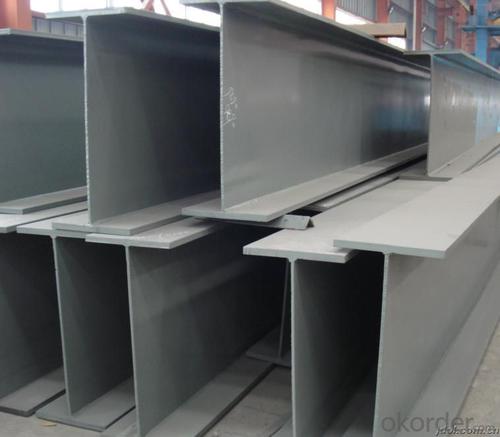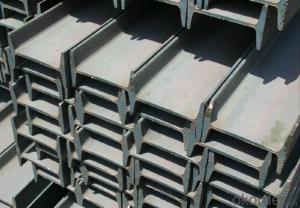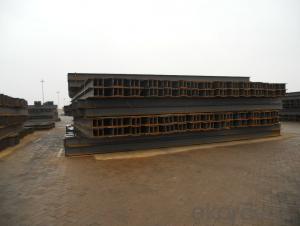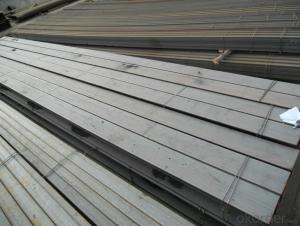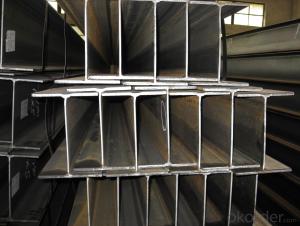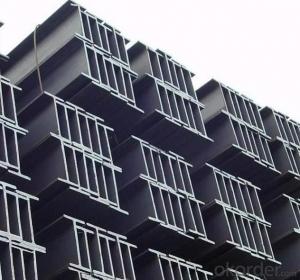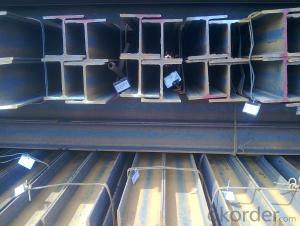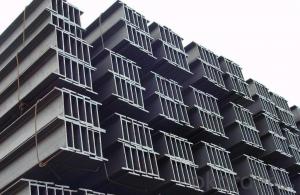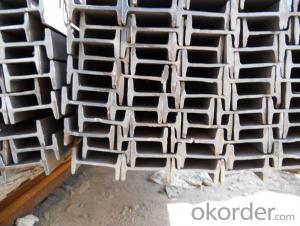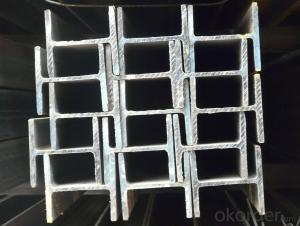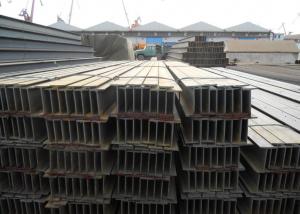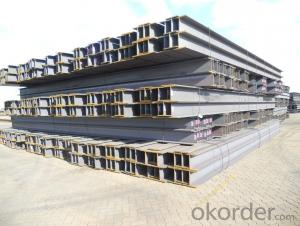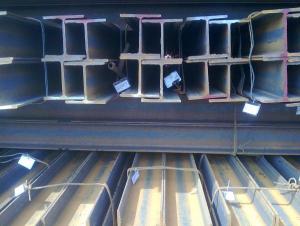GB Standard Steel H Beam 340mm-350mm with High Quality
- Loading Port:
- China main port
- Payment Terms:
- TT or LC
- Min Order Qty:
- 40 m.t
- Supply Capability:
- 15000 m.t/month
OKorder Service Pledge
OKorder Financial Service
You Might Also Like
Specifications of GB Standard Steel H Beam 340mm-350mm with High Quality For Sale:
1. Standard: GB Standard
2. Grade: Q235
3. Length: 12m
Size and Mass:
| Size (mm) | Mass (Kg/m) | Size (mm) | Mass (Kg/m) |
| 350*175*7.0 | 49.4 | 344*348*10.0 | 113 |
| 340*250*9.0 | 78.1 | 350*350*12.0 | 135 |
Usage & Applications of GB Standard Steel H Beam 340mm-350mm with High Quality For Sale:
Commercial building structure ;Pre-engineered buildings; Machinery support structure; Prefabricated structure; Medium scale bridges; Ship-building structure, etc
Packaging & Delivery of GB Standard Steel H Beam 340mm-350mm with High Quality for Building Structures:
1. Packing: it is nude packed in bundles by steel wire rod
2. Bundle weight: not more than 3.5MT for bulk vessel; less than 3 MT for container load
3. Transportation: the goods are delivered by truck from mill to loading port, the maximum quantity can be loaded is around 40MTs by each truc4. If the order quantity cannot reach the full truck loaded, the transportation cost per ton will be little higher than full load.
4. Delivered by container or bulk vessel
Production flow of GB Standard Steel H Beam 340mm-350mm with High Quality:
Material prepare (billet) —heat up—rough rolling—precision rolling—cooling—packing—storage and transportation
FAQ:
Q1: Why buy Materials & Equipment from OKorder.com?
A1: All products offered byOKorder.com are carefully selected from China's most reliable manufacturing enterprises. Through its ISO certifications, OKorder.com adheres to the highest standards and a commitment to supply chain safety and customer satisfaction.
Q2: How do we guarantee the quality of our products?
A2: We have established an advanced quality management system which conducts strict quality tests at every step, from raw materials to the final product. At the same time, we provide extensive follow-up service assurances as required.
Q3: How soon can we receive the product after purchase?
A3: Within three days of placing an order, we will arrange production. The shipping date is dependent upon the quatity, how many sizes you want and the plan of production, but is typically 1 month to 2 month days from the beginning of production.
Images of GB Standard Steel H Beam 340mm-350mm with High Quality:

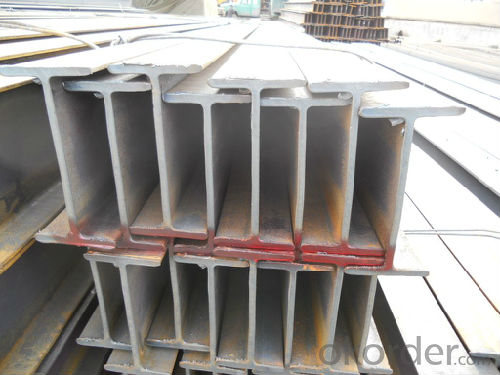
*If you would like to get our price, please inform us the size, standard/material and quantity. Thank you very much for your attention.
- Q: How do Steel H-Beams contribute to the overall architectural design of a structure?
- Steel H-beams are an essential component in the architectural design of a structure as they provide crucial support and stability. These beams are specifically designed to bear heavy loads and distribute weight efficiently, making them ideal for constructing large-scale structures such as buildings, bridges, and industrial facilities. One of the primary contributions of steel H-beams to the overall architectural design is their ability to span long distances without the need for additional support columns or walls. This feature allows architects to design open and flexible floor plans, maximizing the usable space within a structure. The absence of intermediate columns not only enhances the aesthetic appeal but also provides freedom in creating large, uninterrupted spaces. In addition to their functional benefits, steel H-beams also offer aesthetic advantages to the architectural design. They provide a sleek and modern appearance, with their clean lines and minimalistic design. This visual appeal makes them a popular choice for contemporary and industrial-style structures, adding an element of sophistication and elegance to the overall design. Moreover, steel H-beams are incredibly versatile in terms of their adaptability to various architectural styles. They can be easily integrated into different designs, whether it be a traditional or modern structure. The flexibility of these beams allows architects to create unique and innovative designs that meet both the functional and aesthetic requirements of a project. Furthermore, steel H-beams contribute to the overall architectural design by providing structural integrity and durability. The high-strength steel used in their construction ensures that the structure can withstand heavy loads, environmental forces, and natural disasters. This durability not only ensures the safety of occupants but also minimizes maintenance and repair costs over time. In conclusion, steel H-beams play a crucial role in the architectural design of a structure by providing support, stability, and flexibility. They enable the creation of open and spacious interiors, add a modern and sophisticated touch to the design, and ensure structural integrity and durability. Whether it is for a commercial building, a residential project, or an industrial facility, steel H-beams are an indispensable element that contributes to the overall success and functionality of the architectural design.
- Q: Are steel H-beams suitable for use in the construction of correctional facilities or prisons?
- Yes, steel H-beams are suitable for use in the construction of correctional facilities or prisons. They provide superior strength and durability, which is crucial for the security and safety requirements of such facilities. Steel H-beams are capable of supporting heavy loads, providing structural stability, and withstanding extreme weather conditions, making them an ideal choice for prison construction projects.
- Q: Can steel H-beams be used in utility infrastructure projects?
- Yes, steel H-beams can be used in utility infrastructure projects. They are commonly used in bridges, buildings, and other structures due to their strength, durability, and ability to support heavy loads. In utility projects, H-beams can be utilized for constructing support structures, such as transmission towers or substations, where strength and stability are crucial.
- Q: What are the common methods for joining steel H-beams in construction?
- Steel H-beams can be joined in construction using various methods. The most frequently employed technique is welding, where the beams are aligned and fused together through arc welding or gas welding. This creates a sturdy and long-lasting connection, ensuring the structural integrity of the beams. Another method involves using bolts to connect the steel H-beams. Holes are drilled into the flanges, and bolts are inserted through these holes and tightened with nuts. This allows for easy disassembly and reassembly if required. Riveting is an alternative method that involves using rivets to join the steel H-beams. Holes are drilled into the flanges and web, and rivets are inserted and secured through hammering or pressing. However, this method is time-consuming and has been largely replaced by welding and bolted connections. In some cases, adhesive bonding can be used to join steel H-beams. High-strength adhesives are applied to the surfaces of the beams, and they are then pressed together. Although not as commonly used as welding or bolted connections, adhesive bonding can be a viable option in certain situations. Overall, welding and bolted connections are the predominant methods for joining steel H-beams in construction. These techniques provide robust and reliable connections, ensuring the stability and integrity of the structure.
- Q: Can steel H-beams be used in sports arena structures?
- Yes, steel H-beams can be used in sports arena structures. Steel H-beams are commonly used in construction due to their high strength-to-weight ratio, which makes them suitable for supporting heavy loads. Sports arenas require sturdy structural elements to support the weight of the roof, seating, and other equipment. H-beams provide the necessary strength and stability to withstand the forces exerted on the structure during events. Additionally, steel H-beams can be easily fabricated and assembled, allowing for efficient construction of sports arena structures. Their versatility also allows architects and engineers to design unique and innovative arena layouts, accommodating various seating arrangements and architectural features. Furthermore, steel H-beams offer durability and resistance to environmental factors such as corrosion, making them ideal for long-lasting sports arena structures. The material's low maintenance requirements also contribute to its popularity in construction projects. Overall, steel H-beams are a reliable and commonly used choice for sports arena structures, providing the necessary strength, versatility, and durability required for such large-scale projects.
- Q: What are the limitations of using steel H-beams?
- There are several limitations associated with using steel H-beams. Firstly, steel H-beams are heavy and bulky, which can make transportation and handling difficult. Their weight also makes them more expensive to transport, especially over long distances. Additionally, the size and weight of steel H-beams may require specialized equipment and infrastructure for installation, which can further increase costs. Secondly, steel H-beams have limited flexibility in terms of design and shape. They are typically manufactured in standard sizes and lengths, which may not always align with specific project requirements. This limitation can result in additional cutting, welding, or modification, adding both time and cost to the construction process. Thirdly, steel H-beams are susceptible to corrosion and require regular maintenance to prevent rusting. Exposure to moisture, chemicals, and environmental elements can weaken the structural integrity of the beams over time, reducing their lifespan and necessitating repairs or replacements. Furthermore, steel H-beams have lower resistance to fire compared to other building materials such as concrete. In the event of a fire, the steel beams can lose their strength and structural stability, potentially compromising the safety of the structure. Lastly, steel H-beams have a relatively high carbon footprint due to the energy-intensive processes involved in their production. The extraction of raw materials, such as iron ore and coal, and the subsequent manufacturing processes contribute to greenhouse gas emissions and environmental degradation. In conclusion, while steel H-beams offer excellent load-bearing capacity and structural strength, they come with limitations such as weight, inflexibility in design, susceptibility to corrosion, reduced fire resistance, and a high carbon footprint. These factors need to be carefully considered when choosing steel H-beams as a construction material.
- Q: Are steel H-beams resistant to corrosion?
- Steel H-beams generally exhibit resistance to corrosion. Steel, a highly durable and adaptable material, possesses the ability to withstand exposure to weather conditions and various environmental factors. However, the degree of corrosion resistance may vary depending on the specific steel type utilized and the presence of protective coatings. When it comes to H-beams crafted from carbon steel, their susceptibility to corrosion increases, particularly in humid or corrosive surroundings. To bolster their resistance against corrosion, H-beams can undergo processes like galvanization or application of protective layers such as paint or epoxy. These coatings function as a barrier, effectively hindering moisture and other corrosive elements from reaching the steel surface. Consistent maintenance and proper care are also vital in preserving the corrosion resistance of steel H-beams over time.
- Q: How are steel H-beams connected or joined together in construction?
- Steel H-beams, also known as I-beams, find wide application in construction due to their strength and load-bearing capabilities. The connection or joining of these beams is accomplished using various techniques, depending on the specific construction project and its requirements. Welding stands as one of the most prevalent methods for joining steel H-beams. This technique involves heating the two beams at the connection point and subsequently fusing them together using a welding electrode. This results in a robust and enduring bond between the beams. Welding is extensively utilized in construction because it ensures a reliable and sturdy connection, thereby guaranteeing the structural integrity of the building. Bolting serves as another method employed to connect steel H-beams. It entails the use of bolts, nuts, and washers to secure the beams together at the connection point. Holes are drilled through the beams, and bolts are inserted and tightened using a wrench or spanner. Bolting is a popular choice as it allows for easy disassembly and reassembly, making it suitable for projects that may necessitate modifications or relocation in the future. In certain instances, steel H-beams can also be connected using rivets. Riveting involves the drilling of holes through both beams and subsequently inserting cylindrical metal pins known as rivets. These rivets are then hammered or compressed to securely fasten the beams together. Although riveting was extensively employed in the past, it has become less prevalent in modern construction due to the time-consuming nature of the process. Nevertheless, it can still be utilized in specific situations where the desire for aesthetically pleasing or historically significant riveted connections exists. Lastly, adhesive bonding can also be utilized to connect steel H-beams. This method entails the application of a strong adhesive or epoxy to the connection point, followed by the pressing of the beams together. Adhesive bonding offers the advantage of providing a clean and visually appealing connection without the need for visible welds or bolts. However, it is less commonly employed in construction due to the potential challenges involved in achieving a reliable and enduring bond. In conclusion, steel H-beams can be connected or joined together in construction through methods like welding, bolting, riveting, or adhesive bonding. The selection of the joining method depends on the specific project requirements, structural considerations, and aesthetic preferences.
- Q: What are the different types of steel used for manufacturing H-beams?
- When manufacturing H-beams, various factors need to be considered in order to select the appropriate type of steel. These factors include the required strength, durability, and cost-effectiveness for the specific application. 1. The most commonly used type of steel in H-beam manufacturing is carbon steel. It consists primarily of iron and carbon, with small amounts of other elements. Carbon steel is well-known for its affordability and high strength, making it a popular choice for a wide range of applications. 2. Another type of steel used for H-beams is alloy steel. This type of steel contains additional alloying elements such as chromium, nickel, or molybdenum. These elements enhance the steel's strength, hardness, and resistance to corrosion. Alloy steel H-beams are often used in heavy-duty construction projects or applications that require exceptional strength. 3. Stainless steel is a type of steel that contains a minimum of 10.5% chromium. This gives it excellent resistance to corrosion and staining. H-beams made from stainless steel are commonly used in applications where hygiene, durability, and aesthetic appeal are critical, such as in the food industry or architectural structures. 4. High-strength Low-alloy (HSLA) steel is another type of steel used for H-beams. It provides high strength and improved toughness compared to standard carbon steel. HSLA steel often contains small amounts of alloying elements such as vanadium, niobium, or titanium, which enhance its mechanical properties. HSLA steel H-beams are commonly used in applications that require a high strength-to-weight ratio, such as bridges or heavy machinery. 5. Weathering steel, also known as Corten steel, is a type of steel that develops a protective layer of rust when exposed to the elements. This layer acts as a barrier against further corrosion and eliminates the need for painting or maintenance. Weathering steel H-beams are often utilized in outdoor structures like bridges or sculptures. Considering factors such as strength, durability, corrosion resistance, and cost-effectiveness, it is crucial to select the appropriate type of steel for manufacturing H-beams based on the specific requirements of the project.
- Q: What are the considerations when designing for sustainable materials in Steel H-Beams?
- When it comes to designing Steel H-Beams with sustainable materials, there are several important factors to consider. These considerations revolve around the impact on the environment, the cost-effectiveness, the durability, and the overall sustainability of the materials used. 1. Environmental Impact: When incorporating sustainable materials, it is crucial to minimize the environmental impact throughout the lifecycle of the H-Beams. This can be achieved by responsibly sourcing materials from forests that are managed well or by utilizing recycled steel, which helps reduce deforestation and carbon emissions. 2. Energy Efficiency: Another crucial factor to consider is the energy efficiency of the manufacturing process. Designers should aim to reduce energy consumption and greenhouse gas emissions by selecting materials that require less energy to produce or by using energy-efficient manufacturing techniques. 3. Durability and Longevity: Sustainable materials should be durable and have a long lifespan. By designing H-Beams that are resistant to corrosion, wear, and tear, it reduces the need for frequent replacements, thereby minimizing waste and resource consumption. 4. Recyclability: The ability to recycle and reuse materials is essential in sustainable design. Steel H-Beams should be designed in a way that allows for easy disassembly and recycling at the end of their lifespan. This promotes a circular economy and reduces the demand for new raw materials. 5. Cost-effectiveness: While sustainability is a primary goal, it is also important to consider the cost-effectiveness of the materials used. Designers should strive to strike a balance between sustainability and affordability, ensuring that the use of sustainable materials does not compromise the overall project budget. 6. Compliance with Standards and Certifications: Designers should consider materials that meet recognized sustainability standards and certifications, such as LEED (Leadership in Energy and Environmental Design) or Cradle to Cradle. These certifications ensure that the materials have been responsibly sourced and manufactured. 7. Collaborative Approach: Finally, it is crucial to involve stakeholders, including architects, engineers, and manufacturers, in the decision-making process. By collaborating and sharing knowledge, the design team can identify innovative solutions that promote sustainability and address any challenges related to using sustainable materials in Steel H-Beams.
Send your message to us
GB Standard Steel H Beam 340mm-350mm with High Quality
- Loading Port:
- China main port
- Payment Terms:
- TT or LC
- Min Order Qty:
- 40 m.t
- Supply Capability:
- 15000 m.t/month
OKorder Service Pledge
OKorder Financial Service
Similar products
Hot products
Hot Searches
Related keywords



